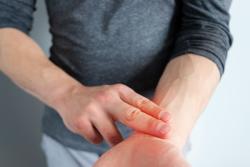Staying Safe – Staying Hydrated in the Heat
Recipes and Nutrition Tips – Melon Fruit Salad
Physical Activity Tips – Measuring Your Heart Rate
Food Access Resources in Massachusetts – Apply for SNAP Benefits in Massachusetts
Staying Safe
 Stay hydrated in the hot summer heat.
Stay hydrated in the hot summer heat.
Your body needs water to survive, and staying hydrated is important for your body to function properly. Drink enough fluids to prevent dehydration during the summer months. Follow these tips to stay safe.
- Drink water throughout the day and at all meals.
- Drink more water when it is hot outside and when exercising.
- Keep a glass of water or a water bottle nearby to remind you to drink water. Drink water throughout the day—don’t wait until you feel thirsty to start drinking water.
- Create infused water with flavors you like. Try adding lemon or orange wedges, sliced strawberries or cucumbers, or mint leaves, ginger, or a cinnamon stick.
- Eat fruits and vegetables with a high water content, such as watermelon, cucumbers, cantaloupes, tomatoes, and peaches.
Recipes and Nutrition Tips
 Stay hydrated this summer with fresh fruits and vegetables.
Stay hydrated this summer with fresh fruits and vegetables.
Melons, like watermelon and cantaloupe, have a high water content, at more than 90 percent. Beat the heat and treat your family to a Melon Fruit Salad. This summer salad will be a hit served as a side dish at a summer barbeque or for a festive dessert. Strive for 1½ to 2 servings of fruit each day.
Watch this video and learn how to make Citrus Kohlrabi Salad for another summer salad full of hydrating fruits and vegetables: https://video.link/w/SGfP .
Physical Activity Tips
 Do you know how to measure your heart rate?
Do you know how to measure your heart rate?
According to Harvard Health, measuring your heart rate is an easy way to check your general health. The heart rate provides a real-time snapshot of the heart muscle’s function. Additionally, monitoring your heart rate can be used to improve fitness goals.
 Learn how to measure your heart rate from your wrist or the side of your neck by following these steps.
Learn how to measure your heart rate from your wrist or the side of your neck by following these steps.
At the wrist, lightly press the index and middle fingers of one hand on the opposite wrist, just below the base of the thumb.
At the neck, lightly press the side of the neck with your fingertips, just below the jawbone.
When you feel a pulse, count the number of beats for 15 seconds and then multiply that number by four to calculate the beats per minute. That is your heart rate.
What is a healthy range?
For adults, 60 to 100 beats per minute is considered the normal range. Physically fit individuals might have a heart rate lower than 60 beats per minute. Monitoring your heart rate is a good way to track health trends and patterns. Unusually high or low heart rates can indicate a health concern. Illness and genetics can affect your heart rate. Learn more about monitoring your heart health at https://www.health.harvard.edu/heart-health/want-to-check-your-heart-rate-heres-how.
Food Access Resources in Massachusetts
You may be eligible for the Massachusetts Supplemental Nutrition Assistance Program (SNAP). Apply for SNAP benefits using the link below. https://dtaconnect.eohhs.mass.gov
Are you looking for new recipes and money-saving ideas?
Visit Massachusetts Healthy Foods in a SNAP. You will find recipes and nutrition education materials designed just for you. Also find information on food planning during the COVID-19 pandemic and advice from the United States Department of Agriculture https://www.mahealthyfoodsinasnap.org/.

